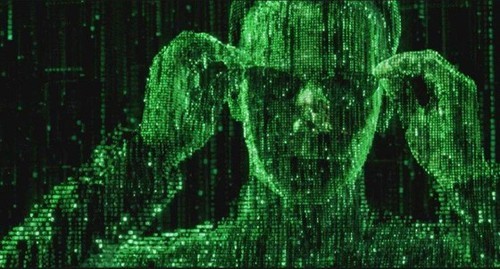Unfortunately, no one can be told what the Matrix is

“Unfortunately, no one can be told what the Matrix is. You have to see it for yourself.”
This quote is by Neo, the main character of the matrix trilogy. Neo says it in the third part, called matrix- the revolution.
The matrix trilogy is by the Wachowski brothers, who worked over 30 years to film this special movie trilogy.
The outstanding thing about the movies is the borrowed elements and topics form different disciplines, times, stories and even religions.
This broader horizon up values the movie and turns this action movie into deep and challenging entertainment. Just to name a few: the philosophical connection happens through the epistemology in Plato’s allegory of the the cave, religious connections happen though Gnosticism, Zen-Buddhism and also links to the Old and New Testament of the Bible.
The bible connections happen for example through names and places: Thomas Anderson (Anderson meaning “son of man”=Jesus) a.k.a Neo, the risen born again is an anagram of “one” (meaning the one/chosen). The main character is called Trinity. Other have names like Morpheus, Cypher (for Lucifer), Apoc (for apocalypse). The last resort and refuge after the earth is destroyed is called Zion.
There are also many parallels between the life of Jesus and of the main character Neo.
He is born in an artificial womb, which stages his birth almost like a vigin birth. He is proclaimed as the chosen by Morpheus, which reminds of Jesus’ baptism. Neo is also surrounded by a betrayer (his Jude is called Cypher). And at the end, Neo suffers being a sacrifice. But he also rises on the third day.
Is it a Christian allegory?
Or is it a modern day adaption, selectively choosing different mindsets to tell a story. Or perhaps it is even really a matrix (lat. for uterus, womb or dam),
that provides a system and logical to understand everything and put it into oder.
This week I read “The matrix of Christian ethics – Integrating philosophy and moral theology in a postmodern context by Patrick Nullens and Ronald T. Michener.
“Unfortunately, no one can be told what the Matrix is. You have to see it for yourself.”
I saw it and read it for myself – and really enjoyed it. It supplies with an systematical … of ethics. The main strength is, that Nullens and Michener construct their study as a permanent diffusion into Christian and especially biblical theology and on the other hand with a strong relevance for relevant and contemporary questions in our society. Commands, principles, values and virtues are worked out to be fruitful for the ethical discussion in the light of today but always with a connection to biblical (in my eyes nuanced evangelical) theology. The framework that Nullens and Michener construct out of that is called “matrix of Christian ethics.” At the end the authors close with practical thoughts, helping to answer relevant questions in our contemporary culture today. I’ve never read an introduction book in ethical thinking, which was so practical, up to-date and relevant.
As Neo puts it nicely in the Matrx:
“There is a difference between knowing the path and walking the path.”
Nullens and Michener help to understand and know the parth, to enable people to walkt he path in a concious ethical and therefore christian way.
Leave a Reply
You must be logged in to post a comment.